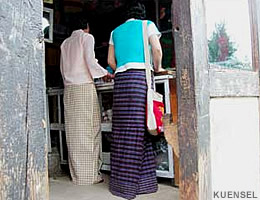| Bhutanese
Traditional Dresses |
 |
Bhutan Culture National Dress |
 |
Bhutan Information |
|
|
 |
|
Kira - Half kira: easy to wear, affordable
|
 |
 |
| Half a kira is better than none? |
| No
harassment of koma (traditional brooch) pricking into the shoulders, suitable
for all kinds of weather, easy to wear, and affordable... the "half kira",
the traditional Bhutanese dress for women, cut at the waist, has literally
changed the dressing norms for Bhutanese women.
A
trend, even a fashion today, the half kira is now worn for many occasions,
from work places at home and offices to official gatherings and sometimes
even in dzongs. |
|
Although
the Kira is being worn without the top half which forms a front pouch the
half kira is not immediately recognised because the woman is covered by
a Tego, a traditional jacket, and a wonju, the blouse, above the waist.
For
most women who prefer to wear a half kira it is the comfort that matters.
"It is easier and less complicated to handle," said a lady. "It is faster
to put on and we can then afford a greater variety in colour and pattern."
One expectant mother added that she is much more comfortable with the half
kira in her state.
The
half kira trend is gaining popularity at a time when Bhutan is strict about
the dress code and the national dress. According to a researcher, Sonam
Kinga, who wrote an article, "Changes in Wearing kira"; people living along
the border areas in late eighties started the trend of wearing half gho
and kira because of the hot weather. The trend was picked up in other areas
because of its convenience.
Interestingly
the half gho became popular only for a while with taxi drivers and truckers
being the most users. It also comprised of two parts, upper and lower,
but it couldn't be worn in the schools and offices.
The
half kira has also been a topic of debate, with some describing it as an
infringement of the national dress code and others calling it an innovation.
Ugyen, a shopkeeper said that people should not over look the value of
our culture just because half kira is easily affordable. "It's a matter
of culture and it cannot be bought with money," he said. "Or has our culture
become so cheap?"
While
some find the trend very innovative some consider it a negative impact
on tradition and on the future generations. "We have to show our ancient
culture to the youth," said a driver. "With the increasing trend of wearing
the half kira, how will they ever know that there once existed a tradition
where women wore a kira, from the shoulder till the ankles."
Many
on the other hand, have a different opinion. They say that wearing a half
kira is a way of promoting culture and presenting it to modern world. "We
prefer to promote our culture with time rather than sticking to the past,"
says Tashi Chozom. "In the process of development, the half kira signifies
the progress which increases our efficiency. Its comfort allows us to work
better."
A
driglam namzha instructor, Tshering Penjor, said that there were no written
rules on the half kira but it crossed the norms of dirglam namzha. "Driglam
Namzha includes details of every part of the dress that we wear but when
women wear the half kira some important tasks like wearing the koma, receiving
a scarf and putting it into the pouch cannot be performed,"
He
added that it was the existing rule to wear a full kira during important
occasions like national day, attending a domche and tsechu, or places like
dzongs, courts, lhakhangs, and formal occasions.
As
the half kira trend picks up blacksmiths say that they hardly get three
or four orders for komas in a month. "It has lost its function," said Nado,
a Thimphu blacksmith.
The
debate goes on. Some Bhutanese believe that the country is losing it culture.
Others say that it is right on track.
| This
article was contributed by Kesang Dema, KUENSEL, Bhutan's National
Newspaper |
 |
| Information on Bhutan |
 |
|




